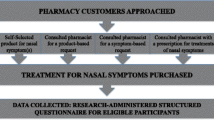Abstract
The over-the-counter (OTC) conversion of loratadine was approved in the US in December 2002 for the treatment of allergic rhinitis, representing the first second-generation antihistamine (SGA) to be made available as an OTC product. This review examines the current evidence regarding the impact of this conversion on healthcare resource utilization and costs. Simulated decision models represent the majority of the research conducted in this area and appear to suggest that the availability of OTC loratadine reduces patient cost sharing, health-plan costs, and motor-vehicle accidents, and also improves work-related productivity. Other empirical research examining the policies adopted by health plans in response to the availability of OTC loratadine suggests that restricting access to prescription SGAs by placing these products in the third tier, thereby encouraging patients to purchase OTC loratadine, results in the greatest reduction in pharmacy-related costs for SGAs. However, early evaluations of such policies using health-plan data for the year 2003 show mixed results. Initial conclusions suggest that OTC loratadine has the potential to function as a safer treatment alternative to the sedating first-generation antihistamines in the treatment of allergic rhinitis. What is unclear is the impact of OTC loratadine on overall healthcare costs, as patients may choose the convenience of an OTC alternative to manage their allergic rhinitis in lieu of physician-supervised care. Further research is needed to examine if patients are unable to correctly diagnose their allergic rhinitis symptoms, which could potentially mask other chronic conditions and result in increased healthcare utilization and associated expenditures.

Similar content being viewed by others
References
Furier MD, Rolnick MS, Lawday KS, et al. Cost impact of switching histamine(2)-receptor antagonists to non prescription status. Ann Pharmacother 2002 Jul/Aug; 36: 1135–41
Ya-Chen TS, Prasad M, Luce BR, The effect of social welfare on a switch of second generation antihistamines from prescription to over-the-counter status: a microeconomic analysis. Clin Ther 2002; 24(4): 701–16
IMS Health, Inc. Integrated promotional services and CMR, 2002. Fairfield (CT): IMS Health, Inc., 2002
Drug Cost Management Report. Health plan formularies contend with Claritin’s OTC debut — illustration. 2003 Mar [online]. Available from URL: http://www.findarticles.com/p/articles/mi_m0NKV/is_3_4/ai_98626333 [Accessed 2006 Mar 23]
Brass EP. Changing the status of drugs from prescription to over-the-counter availability. N Engl J Med 2001; 345(11): 810–6
Saranow J, Marcus AD. As Claritin sells over the counter, prices for competitors climb. The Wall Street Journal, 2002 Dec 10
Finkle WD, Adams JL, Greenland S, et al. Increased risk of serious injury following an initial prescription for diphenhydramine. Ann Allergy Asthma Immunol 2002; 89: 244–50
Gaillard AW, Gruisen A, de Jong R. The influence of antihistamines on human performance. Eur J Clin Pharmacol 1988; 35(3): 249–53
Cockburn IM, Bailit HL, Berndt ER, et al. Loss of work productivity due to illness and medical treatment. J Occup Environ Med 1999; 41(11): 948–53
Kay GG, Quig ME. Impact of sedating antihistamines on safety and productivity. Allergy Asthma Proc 2001; 22(5): 281–3
Sullivan PW, Follin SL, Nichol MB. Cost benefit analysis of first generation antihistamines in the treatment of allergic rhinitis. Pharmacoeconomics 2004; 22(14): 929–42
Casale TB, Blaiss MS, Gelfand E, et al. First do no harm: managing antihistamine impairment in patients with allergic rhinitis. J Allergy Clin Immunol 2003; 111: 835–42
Kalish SC, Bohn RL, Avorn J. Policy analysis of histamine2-receptor antagonists to over-the-counter use. Med Care 1997; 35(1): 32–48
Andrade SE, Gurwitz JH, Fish LS. The effect of Rx-to-OTC switch on medication prescribing patterns and utilization of physician services: the case of his-tamine2-receptor antagonists. Med Care 1999; 37(4): 424–30
Glass DJ, Harper AS. Assessing satisfaction with desloratadine and fexofenadine in allergy patients who report dissatisfaction with loratadine. BMC Fam Pract 2003; 4(10): 1–6
Sullivan PW, Follin SL, Nichol MB. Transitioning the second generation antihistamines to over-the-counter status: a cost effectiveness analysis. Med Care 2004; 41(12): 1382–95
Sullivan PW, Nichol MB. The economic impact of payer policies after the Rx-to-OTC switch of second generation antihistamines. Value Health 2004; 7(4): 402–11
Delate T, Henderson RR, Motheral BR. Financial impact of benefit design choice for non-sedating antihistamines [online]. Available from URL: http://www.express-scripts.com/ourcompany/news/outcomesresearch/onlinepublications/ [Accessed 2004 Sep 16]
Sullivan PW, Nair KV, Patel B. The impact of changes in prescription drug benefits for second generation anti-histamines in utilization and costs of therapy. Am J Manag Care 2005; 11(6): 374–82
Kailner M. H1-antihistamines in the elderly. Clin Allergy Immunol 2002; 17: 465–81
Posey LM. Allergists hot over antihsitamine restrictions [online]. Available from URL: http://www.pharmacist.com/articles/h_ts_0330.cfm [Accessed 2006 Mar 23]
Academy of Allergy, Asthma & Immunology; American College of Allergy, Asthma & Immunology; and Joint Council of Allergy, Asthma & Immunology. Position statement: insurance coverage for H1-antihistamines. Implications for quality healthcare and public safety [online]. Available from URL: http://www.acaai.org/NR/rdonlyres/63910892-lE08-4D30-8279-33AEC8DB51A9/0/antihis.pdf
Sax B. Hot OTCs: blockbuster switches and niche items drive OTCs [online]. Available from URL: http://www.pharmacytimes.com/article.cfm?ID=1177 [Accessed 2006 Mar 23]
Acknowledgments
No sources of funding were used to assist in the preparation of this manuscript. Some of the studies cited represent research conducted by the author and other researchers.
Author information
Authors and Affiliations
Corresponding author
Rights and permissions
About this article
Cite this article
Nair, K.V. Prescription to Over-the-Counter Switch of Second-Generation Antihistamines (Loratadine). Dis-Manage-Health-Outcomes 14, 69–74 (2006). https://doi.org/10.2165/00115677-200614020-00001
Published:
Issue Date:
DOI: https://doi.org/10.2165/00115677-200614020-00001




